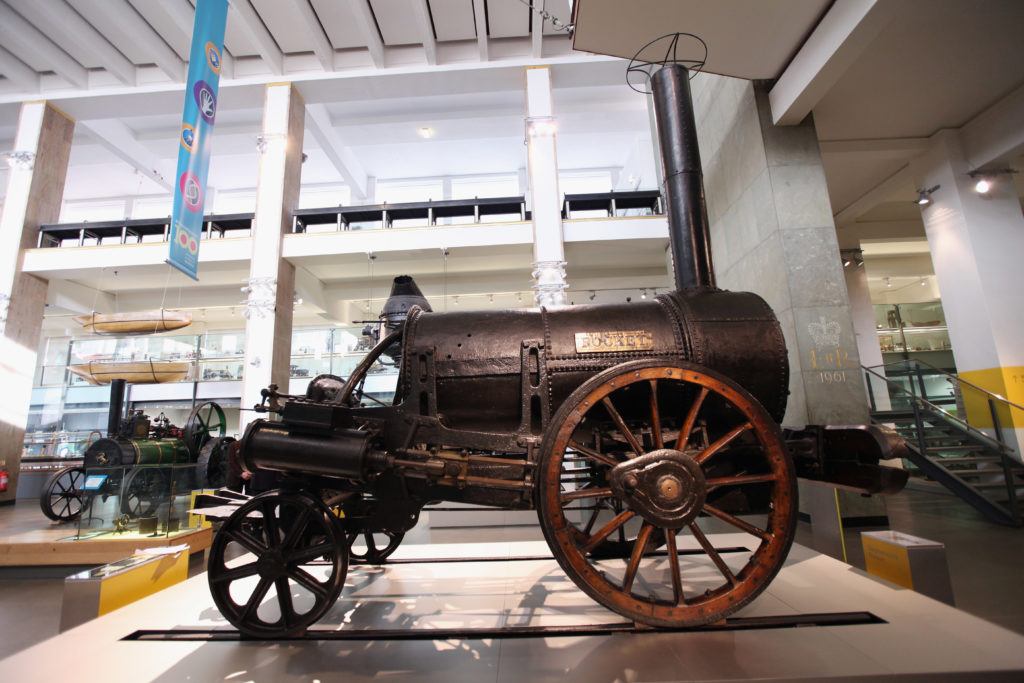The age of steam. Credit: Matt Cardy/Getty Images

Something unusual is happening in Tyneside. At the height of the Summer heat wave, when most of us felt like doing as little as possible, Tynesiders were instead flocking to a museum in the middle of Newcastle – in double their usual numbers. The attraction? Stephenson’s Rocket. On loan to the city’s Discovery Museum from the Science Museum in London until 9 September, the steam engine is part of the Great Exhibition of the North.
Some believe the loan should be permanent. “Stephenson’s Rocket is our Elgin marbles,” says Nick Forbes, leader of Newcastle city council: “It should be here all the time.”
In equating Stephenson’s workaday wrought iron with the marmoreal art of the Parthenon, Councillor Forbes risks hyperbole, but he knows it will get the sympathy of his party leader, Jeremy Corbyn. Mr Corbyn’s views on the Elgin marbles are for him unusually clear: they should be returned to Greece.
But what is so important about Stephenson and his Rocket, and why does Councillor Forbes believe it should stay in the city?
Rocket was a steam locomotive built in 1829 for the new Liverpool and Manchester Railway – the first railway built to carry passengers rather than coal. Rocket was by no means the first locomotive, but she (it’s discourteous to call a steam engine “it”) incorporated several innovations which made her the first engine really capable of hauling passenger trains. Rocket was the template for steam engines for the next century and a half, and is, quite simply, the most famous locomotive in the world.
Rocket was designed and built at the Forth Street works of Robert Stephenson and Company, just round the corner from the Discovery Museum in which she now sits – the first company formed specifically to build railway engines. As such, Rocket is emblematic of the North East’s heavy engineering heritage. Coal mining and ironworking, together with shipbuilding and seafaring, gave “Geordieland” its gritty character – industries now gone.

It’s not surprising therefore that today’s Geordies are keen to see the greatest symbol of the city’s tough, pioneering history. Or that schoolchildren facing an uncertain future in this post-industrial age should be brought by their teachers to see how one of its most famous sons took the Industrial Revolution to a new level.
Tyneside today is brooding as well as depressed. The area voted overwhelmingly for Brexit in a sort of modern-day Jarrow March. Those who visit the Discovery Museum are being inspired by the past – by their cultural heritage. Should Rocket therefore remain in the city indefinitely? Or should it return to London, where visitors from around the world, as well as the whole of Britain, can see what Tyneside could once do – and still might? Would it not serve the region better if Rocket continued to take pride of technological place in the Capital of the nation that once led the world – and has aspirations to do so again – in engineering, technology and innovation?
This in essence is the Elgin Marbles argument too. Isn’t Greece better served by showing the best of its exquisite ancient civilization to millions of visitors from around the world each year (6.25 million people visited the British Museum in 2016-17) – a far greater and more international footfall than could ever be achieved in Athens? “The sculptures are part of everyone’s shared heritage and transcend cultural boundaries” says the museum’s website. It’s a strong intellectual case.
Indeed, Councillor Forbes does Newcastle no good by equating Rocket’s case with that of the Elgin Marbles. “Stephenson’s Rocket is our Elgin marbles” is a clever sound bite, but historically the circumstances of the acquisition of the two artefacts were entirely different. The Elgin Marbles were either purloined or rescued, depending on your viewpoint, but Rocket was bought – legally – by the Liverpool and Manchester Railway. And after being sold on, in 1862 was given by the then owners (a mining company in Cumberland) to the Patent Office Museum, forerunner of the Science Museum.
The leader of Newcastle City Council would do better to make the case that Rocket’s intended final resting place (or, strictly, “long-term display”) – the National Railway Museum in York – fails both of what we might call the ‘Elgin Marbles tests’: it neither returns the artefact to its cherished place of manufacture, nor does it maximise its “shared heritage” by being displayed in one of the greatest tourist centres of the world. The National Railway Museum – for all its appeal – is a comparatively niche attraction. Its footfall is barely 50% more than Newcastle’s. It’s not Rocket science.










Join the discussion
Join like minded readers that support our journalism by becoming a paid subscriber
To join the discussion in the comments, become a paid subscriber.
Join like minded readers that support our journalism, read unlimited articles and enjoy other subscriber-only benefits.
Subscribe